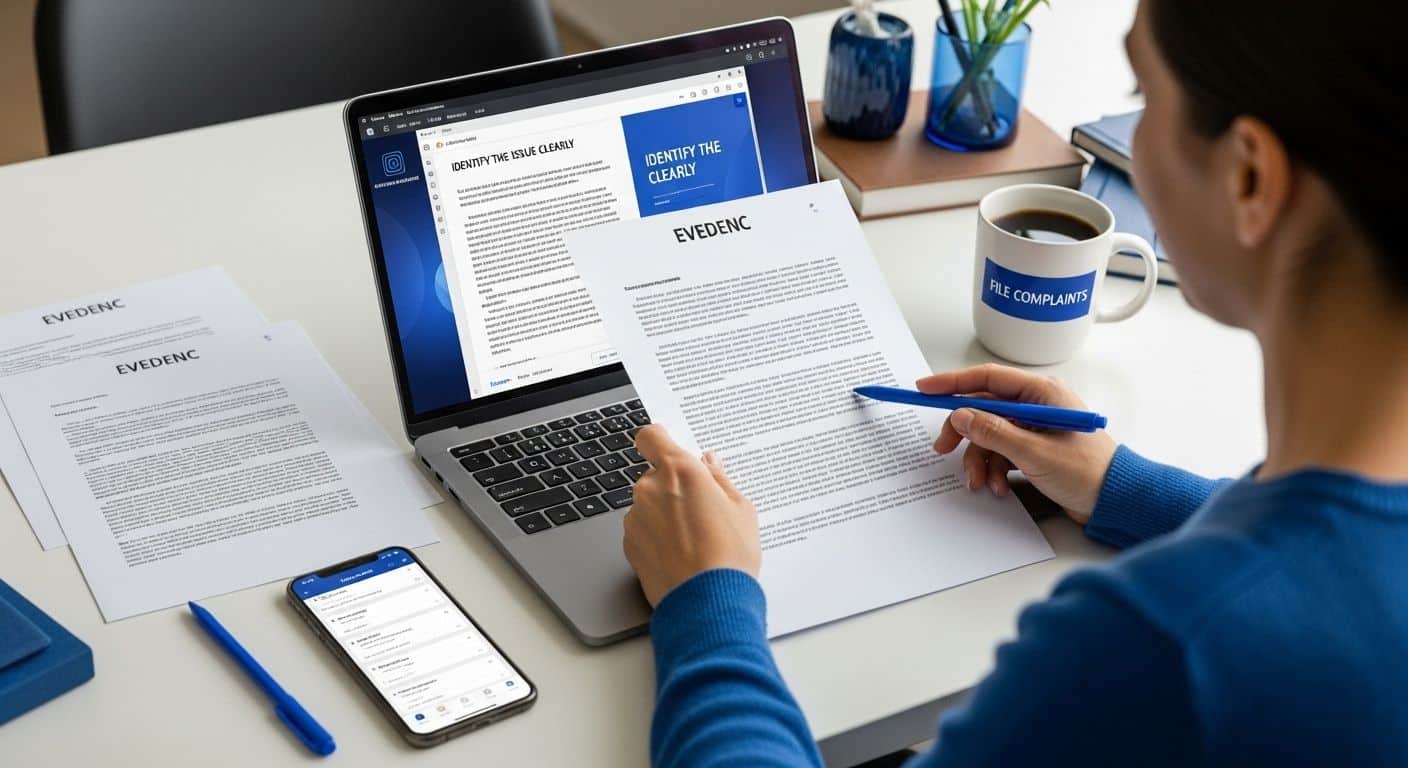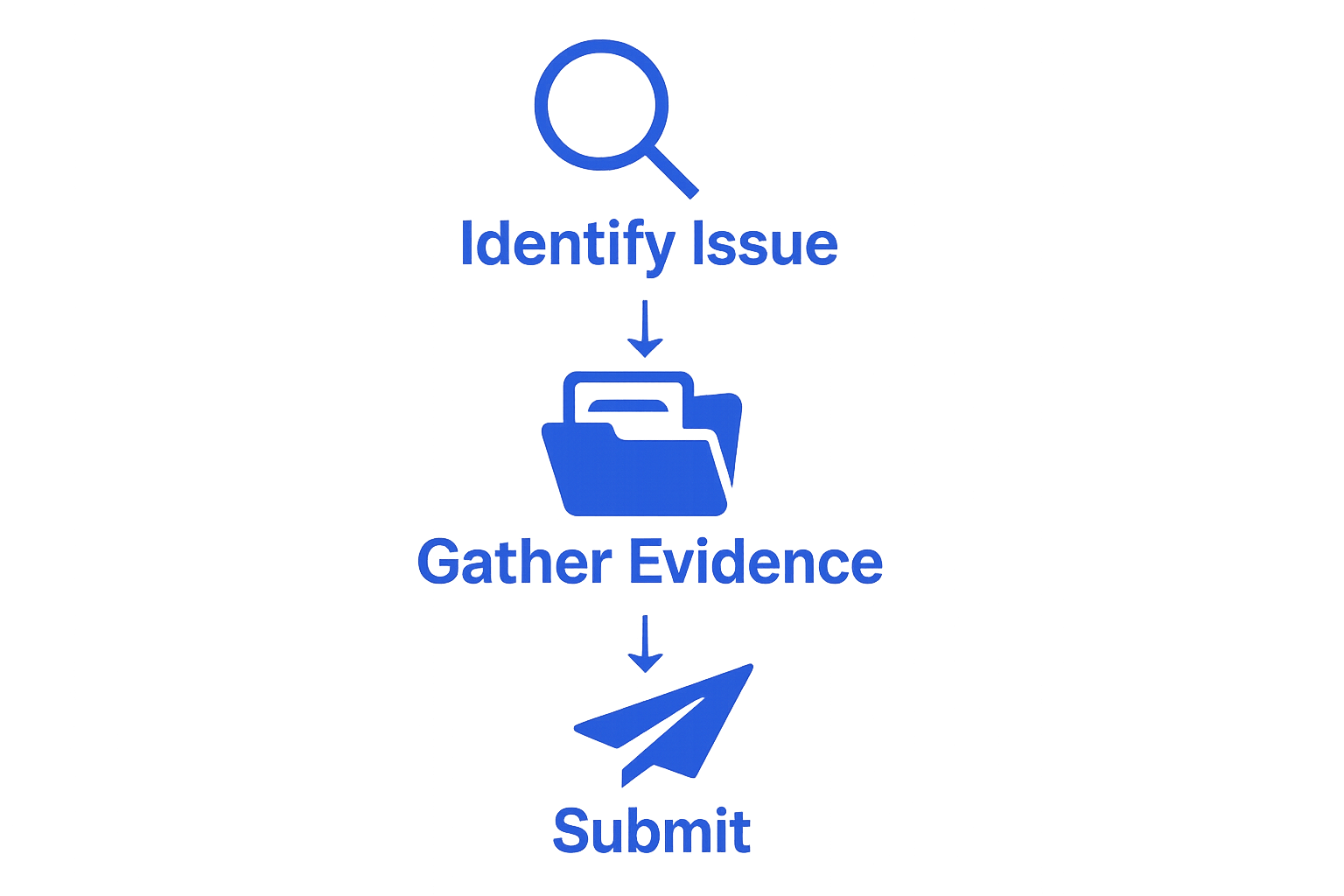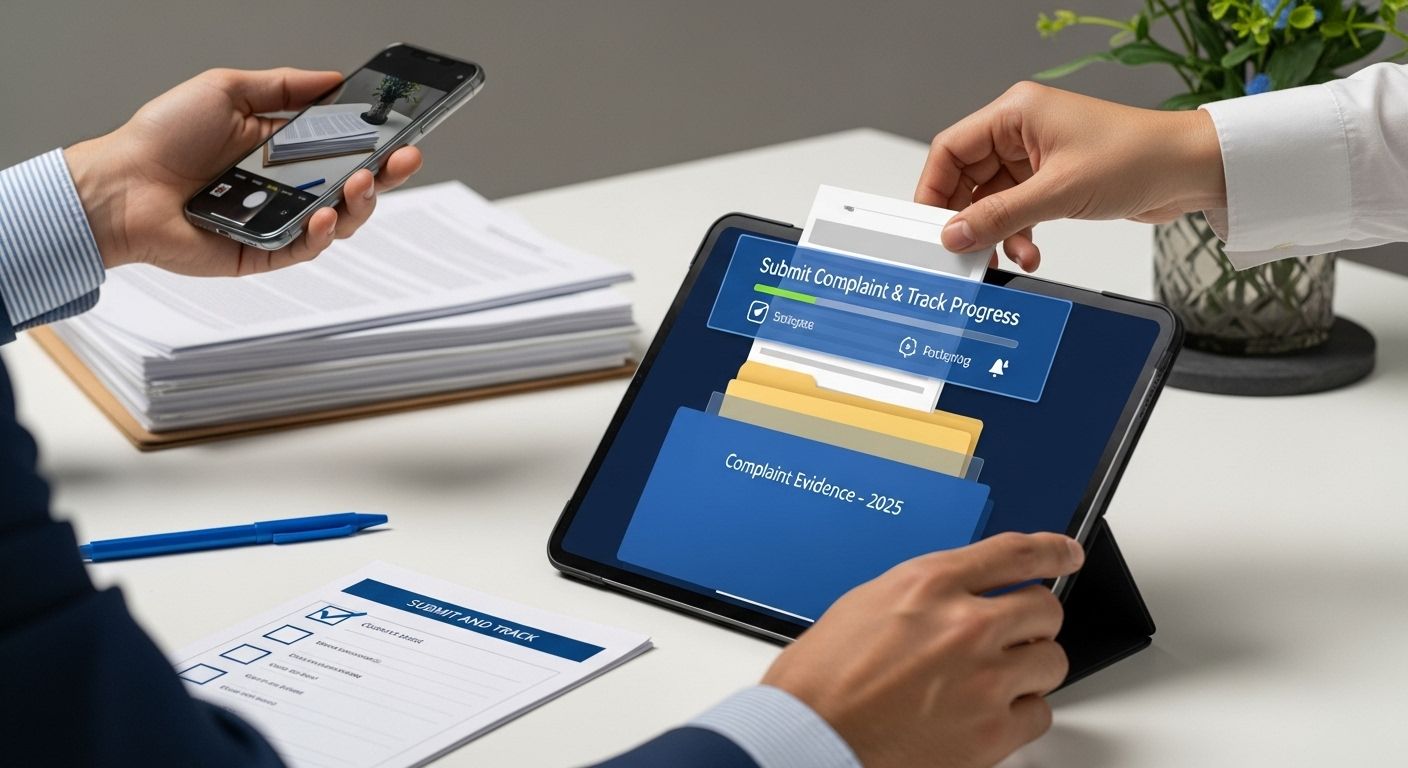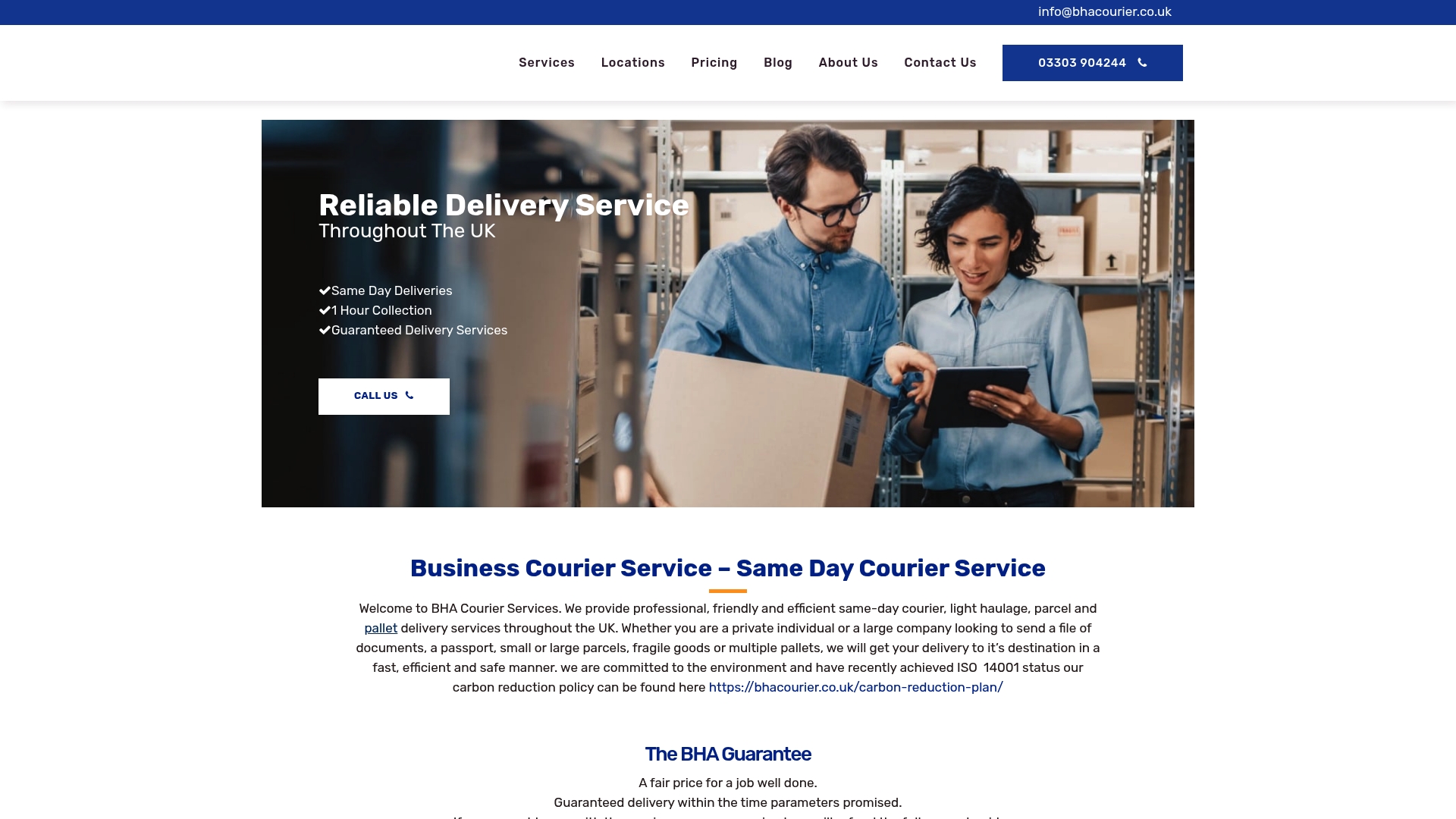
02 Sep How to File Complaints Effectively in 2025
Filing a formal complaint might seem daunting when you are faced with poor service or a broken promise. Yet nearly 70 percent of complaints get resolved when documented and submitted properly. Imagine that. It is not the anger or frustration that gets results. It is all down to clarity, evidence, and approach. The real secret lies in a few precise steps that most people never take.
Table of Contents
- Step 1: Identify The Issue Clearly
- Step 2: Gather Relevant Information
- Step 3: Determine The Appropriate Channel
- Step 4: Compose Your Complaint Thoughtfully
- Step 5: Submit The Complaint And Track Progress
- Step 6: Follow Up And Document The Outcome
Quick Summary
| Key Point | Explanation |
|---|---|
| 1. Clearly Identify the Issue | Accurately state what went wrong, including details and impact, to effectively launch your complaint. |
| 2. Gather Comprehensive Evidence | Collect all relevant documents and proof to substantiate your complaint, enhancing its credibility. |
| 3. Choose the Right Communication Channel | Understand the complaint procedures of the organisation to ensure proper submission and follow-up. |
| 4. Compose a Professional Complaint | Write your complaint clearly and objectively, structuring it logically to effectively communicate your concerns. |
| 5. Follow Up Systematically | Maintain a detailed log and proactively follow up to ensure your complaint receives the attention it needs. |
Step 1: Identify the Issue Clearly
The foundation of any successful complaint process is crystal clear identification of the problem. Before launching into a formal complaint, you must meticulously articulate exactly what went wrong, when it happened, and how it impacted you. This crucial first step determines the effectiveness of your entire complaint strategy.
Start by gathering all relevant documentation and personal records related to the issue. Precision is paramount. Write a comprehensive, chronological narrative detailing the specific events, interactions, or circumstances that triggered your complaint. Include dates, names of individuals involved, communication records, and any tangible evidence such as receipts, emails, contracts, or recordings.
According to the Local Government and Social Care Ombudsman, being clear and concise helps authorities understand and process your complaint more efficiently. Your documentation should answer fundamental questions:
- What exactly happened?
- When did the incident occur?
- Who was responsible?
- What specific harm or inconvenience did you experience?
- What resolution are you seeking?
While documenting your issue, maintain an objective and factual tone. Avoid emotional language or inflammatory statements that might undermine your credibility. Instead, focus on presenting a logical, well-structured account that demonstrates the legitimacy of your complaint.
Verify your documentation by reviewing it critically. Ask yourself whether an independent third party could understand the situation completely from your written explanation. If any details seem ambiguous or incomplete, refine your narrative until it represents a clear, comprehensive picture of the problem.
By investing time in meticulously identifying and documenting your issue, you significantly increase the likelihood of a successful resolution.
 Your thorough preparation sets the stage for effective communication and demonstrates your commitment to resolving the matter professionally.
Your thorough preparation sets the stage for effective communication and demonstrates your commitment to resolving the matter professionally.
Step 2: Gather Relevant Information
After clearly identifying the issue, the next critical step is collecting comprehensive evidence and supporting documentation. This phase transforms your complaint from a vague concern into a substantive, credible communication that demands serious attention.
Documentation is your strongest ally in the complaint process. Begin by creating a dedicated folder or digital file where you can systematically compile all relevant materials. This might include correspondence, contracts, receipts, photographs, recordings, witness statements, and any other tangible proof that substantiates your claim.
According to the Local Government and Social Care Ombudsman, sending copies of supporting documents significantly strengthens your complaint. Organize these materials chronologically, ensuring each document is clear, legible, and directly relevant to the issue at hand.
Consider the perspective of the entity receiving your complaint. They will want a comprehensive understanding of the situation. Your gathered information should transparently demonstrate:
- The sequence of events
- Specific dates and times of incidents
- Direct financial or personal impact
- Attempts to resolve the issue previously
- Potential witnesses or additional corroborating sources
Digital tools can streamline your information gathering. Use cloud storage services like Google Drive or Dropbox to securely store and easily share documents. Screenshot digital communications, save email threads, and maintain a detailed log of phone conversations including dates, times, and names of representatives you spoke with.
Be meticulous about preserving original documents. Create digital backups and keep physical copies in a secure location. Avoid altering any original documentation, as this could compromise the integrity of your complaint.
Verify your information collection by conducting a final review. Ensure every document directly supports your complaint, remove any irrelevant materials, and organize the evidence in a logical, easy-to-follow manner. This preparation demonstrates professionalism and increases the likelihood of a favourable resolution.
Step 3: Determine the Appropriate Channel
Selecting the right communication channel is crucial for ensuring your complaint reaches the appropriate decision makers and receives proper attention. Different organisations have specific complaint procedures, and understanding these nuanced pathways can significantly impact your complaint’s success.
Start by investigating the official complaint mechanism of the specific organisation you are addressing. Most companies provide multiple contact options such as dedicated complaint email addresses, online submission forms, postal addresses, or customer service telephone lines. Prioritise written communication whenever possible, as this creates a verifiable record of your interaction.
According to the Local Government and Social Care Ombudsman, sending copies of supporting documents through the correct channel is essential for effective complaint resolution. Review the organisation’s website or customer service documentation to identify their preferred complaint submission method.
Consider the complexity and urgency of your complaint when selecting a communication channel. Minor issues might be resolved through customer service email or online forms, while more serious concerns may require formal written correspondence or registered mail. For detailed insights into selecting optimal communication channels, explore professional guidance tailored to modern business interactions.
Some strategic channels to consider include:
- Official complaint email addresses
- Dedicated online complaint submission portals
- Formal written letters sent via registered post
- Customer service telephone helplines
- In-person customer service centres
Document each communication attempt, recording the date, method, and any reference numbers provided. This creates a comprehensive audit trail that demonstrates your proactive approach to resolving the issue.
Below is a table comparing the main methods for submitting a complaint, summarising their advantages and when to use each one.
| Submission Method | Best For | Key Advantages | When to Use |
|---|---|---|---|
| Official Complaint Email | Formal complaints, clear records | Quick, traceable, easy to attach files | Most business and service scenarios |
| Online Submission Portal | Standard consumer complaints | Structured forms, automated tracking | When offered by the organisation |
| Written Letter (Registered Post) | Escalated or serious issues | Legal proof of delivery, formal record | Complex or unresolved disputes |
| Telephone Helpline | Urgent or straightforward issues | Immediate response, human interaction | Queries or simple clarifications |
| In-Person at Customer Service | Local issues, personal matters | Direct communication, immediate feedback | When time allows or issue is local |
Verify your channel selection by confirming the organisation’s official complaint handling procedure. Many businesses have specific steps or departments dedicated to managing customer concerns. By following their established protocol, you increase the likelihood of a prompt and satisfactory resolution.
Step 4: Compose Your Complaint Thoughtfully
Crafting a powerful complaint requires strategic communication that balances emotional clarity with professional precision. Your written complaint is your primary advocacy tool, transforming your documented evidence into a compelling narrative that demands attention and resolution.
Begin by structuring your complaint like a professional business communication. Start with a clear, concise opening paragraph that immediately states the purpose of your communication. Include essential details such as your name, contact information, and any relevant reference numbers from previous interactions. Chronological clarity is paramount – present the sequence of events in a logical, easy-to-follow manner that leaves no room for misinterpretation.
According to the Local Government and Social Care Ombudsman, using plain, straightforward language helps authorities understand and process your complaint more effectively. Avoid emotional language, inflammatory statements, or unnecessary personal commentary. Instead, focus on presenting factual information objectively, using precise language that demonstrates the legitimacy of your concern.
Your complaint letter should clearly articulate three fundamental elements:
- The specific problem or incident
- The impact of the issue on you
- The exact resolution you are seeking
Include references to the documentation you have gathered, mentioning specific dates, interactions, and supporting evidence. If you have previous correspondence or communication records, reference these explicitly. Attach copies of relevant documents to provide comprehensive context for your complaint.
Consider the tone and language carefully. While you want to communicate the seriousness of your concern, maintaining a professional and respectful approach increases the likelihood of a positive response. Use straightforward, assertive language that communicates your expectations clearly without appearing aggressive or confrontational.
Verify your complaint document by reading it aloud, checking for clarity, coherence, and completeness. Ensure that an independent reader could understand the entire situation from your written explanation. Proofread meticulously for grammatical errors, typos, or unclear statements that might undermine the credibility of your complaint.
Here is a checklist to help ensure your complaint file is complete and ready for submission.
| Verification Step | Description | Completed (Yes/No) |
|---|---|---|
| Clear Description of Issue | Concise statement of what happened, when, and impact | |
| Chronological Account of Events | Timeline including dates, names, and key interactions | |
| All Relevant Documentation Gathered | Contracts, receipts, emails, photos, recordings as evidence | |
| Organised Supporting Materials | Documents arranged logically and legibly | |
| Contact Details and Reference Numbers | Your contact info and any organisation-assigned reference numbers | |
| Proofread and Objective Tone | Reviewed for clarity, tone, and grammar | |
| Copies of All Submissions Retained | Backup of complaint and evidence saved securely |
Step 5: Submit the Complaint and Track Progress
Submitting your carefully prepared complaint marks a critical transition from preparation to active resolution. The submission process requires strategic documentation and proactive follow-up to ensure your complaint receives the attention it deserves.
Prepare for submission by creating a comprehensive tracking system. This involves making copies of your entire complaint package, including the original letter, supporting documentation, and evidence. Use a dedicated folder or digital storage solution to maintain an organized record of every communication related to your complaint.
According to the UK Cabinet Office, organizations typically acknowledge complaints within specific timeframes. Expect an initial response within 5-20 working days, depending on the complexity of your issue. Immediately after submission, create a detailed log to track key milestones:
- Date of initial complaint submission
- Method of submission (email, post, online form)
- Unique reference or tracking number
- Expected acknowledgement date
- Anticipated resolution timeline
Technology offers powerful tools for complaint tracking. Consider using spreadsheet applications or dedicated complaint tracking apps to monitor progress systematically. Our guide on business communication channels can provide additional insights into effective tracking strategies.
Follow up strategically if you do not receive an acknowledgement within the expected timeframe. Contact the organisation’s customer service department, referencing your original submission and requesting confirmation of receipt. Maintain a professional and persistent approach, documenting each interaction meticulously.
Establish clear communication boundaries by setting realistic expectations for response times. While immediate resolution is ideal, complex complaints may require several weeks of investigation. Request a written update if no substantive response is received within the organisation’s standard processing period.
Verify your tracking process by maintaining a comprehensive, dated record of all interactions. Your systematic approach demonstrates professionalism and provides a clear audit trail, which can be crucial if further escalation becomes necessary.

Step 6: Follow Up and Document the Outcome
The final stage of the complaint process involves meticulous follow-up and comprehensive documentation of the resolution. Your persistent engagement is crucial in ensuring that the complaint receives proper attention and reaches a satisfactory conclusion.
Initiate your follow-up strategy by establishing a clear timeline for expected responses. If the organisation has not provided a resolution within their standard processing period, craft a polite but firm follow-up communication. This correspondence should reference your original complaint, include the initial submission date, and request a specific update on the investigation’s progress.
According to the Health and Safety Executive, systematic documentation of complaint outcomes is essential. Create a comprehensive resolution log that captures every detail of the complaint’s journey. This documentation should include communication dates, names of representatives contacted, discussion summaries, and any promised actions or resolutions.
Your resolution documentation should capture key elements:
- Date of initial complaint
- Date of final resolution
- Specific actions taken by the organisation
- Monetary compensation or remedial actions
- Names and contact details of key personnel involved
- Reference numbers for all communications
Evaluate the effectiveness of the resolution critically. Explore our comprehensive guide on business communication channels to understand how to effectively assess and document complaint outcomes. Determine whether the proposed solution adequately addresses the original issue or if further action is necessary.
If the resolution is unsatisfactory, prepare to escalate your complaint to higher authorities or relevant ombudsman services. Maintain a professional tone, presenting your documented evidence systematically. Your detailed record-keeping will be instrumental in demonstrating the progression and potential shortcomings of the initial complaint resolution.
Verify the completion of your complaint process by conducting a final review of all documentation. Ensure all promised actions have been implemented, and retain a complete file of the entire complaint journey for future reference. This comprehensive approach transforms a potential frustration into a constructive experience of problem resolution.
Turn a Resolved Complaint into a Reliable Solution with BHA Courier
You have just learned how careful documentation and clear communication are vital in resolving complaints. But what if you could prevent delivery complaints altogether? If your business or personal deliveries have suffered from delays, damaged items, or lost documentation, you know the frustration of chasing solutions instead of enjoying peace of mind. BHA Courier delivers the professionalism, rapid response, and transparent tracking that the complaint process described in this article demands.

Switch from problem-solving to problem-prevention. Whether you need secure delivery for urgent legal documents, time-sensitive parcels, or fragile items, our same-day and next-day services ensure your shipment’s journey remains fully documented, protected, and on schedule—every time. Track your consignments from collection to arrival, book online with ease, and rely on an ISO 14001 certified ecological commitment. Act now to experience tested reliability from the moment you send. Visit BHA Courier to explore our booking platform and see how our rapid and secure courier services can remove delivery headaches from your daily routine.
Frequently Asked Questions
How do I effectively identify the issue before filing a complaint?
Clearly articulate what went wrong, when it happened, and how it affected you. Gather all relevant documentation and detail the events chronologically to provide a clear understanding of the issue.
What types of documentation should I gather for my complaint?
Collect correspondence, contracts, receipts, photographs, recordings, and any proof relevant to your claim. Organise these documents chronologically and ensure they clearly support your complaint.
What is the best method to submit my complaint?
Research the official complaint mechanism of the organisation, as they often provide various contact options like email, online forms, or postal addresses. Written communication is recommended for verifiability.
How can I track the progress of my complaint after submission?
Create a detailed log of your complaint submissions, including dates, methods, reference numbers, and expected timelines. Follow up with the organisation if you do not receive an acknowledgement within their standard timeframe.


